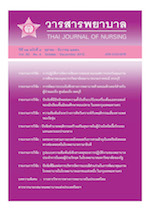ความสัมพันธ์ระหว่างการคิดวิเคราะห์กับพฤติกรรมเสี่ยงทางเพศของวัยรุ่น
Main Article Content
บทคัดย่อ
ผลการวิจัยพบว่านักเรียนที่มีการคิดวิเคราะห์ระดับปานกลาง ระดับสูง และระดับตํ่า มีร้อยละ 52.63, 41.88 และ 5.49 ตามลำดับ นักเรียนร้อยละ 82.84 ไม่มีพฤติกรรมเสี่ยงทางเพศ และที่มีพฤติกรรมเสี่ยงทางเพศในระดับสูงปานกลาง และน้อย พบร้อยละ 8.92, 7.78 และ 0.46 ตามลำดับ การคิดวิเคราะห์มีความสัมพันธ์กับพฤติกรรมเสี่ยงทางเพศในทางลบระดับตํ่า (r = -0.264) อย่างมีนัยสำคัญ ทางสถิติที่ระดับ .01
Relationship between critical thinking and sexual risk behaviors among adolescents.
Aekwarangkoon, S., & Noonill, N.
This descriptive correlational study aimed to describe the critical thinking and sexual risk behaviors among adolescents and its relation. A sample of 437 high school students who joined in comprehensive sex education enhancing project for the youth in 4 upper-southern provinces, was selected using stratified random sampling. Data were collected using the questionnaires which composed 3 parts: 1) personal data, 2) critical thinking, and 3) sexual risk behaviors. The Cronbach’s coefficient alpha of the questionnaires part 2 and 3 were 0.82 and 0.89 respectively. Frequency, percent, mean, standard deviation, and Pearson correlation were used in data analysis.
The results were as follows. (1) The students who had critical thinking at the high, moderate, and low levels were 41.88, 52.63, and 5.49 percents respectively. Students who had no sexual risk behaviors were 82.84 percents, but those who had sexual risk behaviors at the high, moderate, and low levels, were 8.92, 7.78, and 0.46 percents respectively. (2) There was significantly negative relationship between critical thinking and sexual risk behaviors (r = -0.264) at p < .01.


